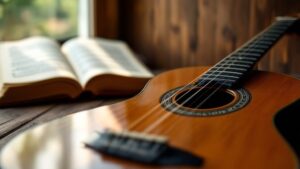Evolution of Classical Guitar Instruction
Classical guitar teaching has grown and changed tremendously since its early beginnings. From one-on-one lessons with master teachers to today's diverse learning environments, the ways of teaching classical guitar continue to develop. Let's explore how these teaching methods have evolved to help students master this beautiful instrument.
Early Approaches and the Rise of Method Books
In the beginning, classical guitar was taught through direct student-teacher relationships. While this personal approach worked well for individual students, it made it difficult to teach larger numbers of people consistently. The creation of printed music and method books changed everything by providing structured lessons that students could follow at their own speed.
The guitar itself has changed over time, influencing how it's taught. For instance, when guitarists switched from gut strings to nylon strings in the 1950s, teachers had to adapt their techniques. These changes in the instrument continue to shape modern teaching approaches.
The Shearer Method and Beyond
Aaron Shearer made huge contributions to guitar education in America. His book Classic Guitar Technique, published in 1963, introduced a clear step-by-step approach using text, pictures, and diagrams to teach classical guitar. Learn more about Shearer's impact. His ideas influenced many guitar programs and teachers who came after him.
Other teachers built on Shearer's work by adding new insights about music theory and effective practice methods. This helped create well-rounded musicians who understood both technique and musicianship.
The Digital Age and Modern Learning
Today's classical guitar students have many more resources available through technology. Online lessons, video tutorials, and interactive apps make it possible to learn from anywhere. Students can now combine traditional in-person lessons with digital tools to create a flexible learning approach.
The internet has also created active communities where guitar students and teachers can connect. These online groups provide opportunities to share feedback, learn from peers, and find mentors. While teaching methods keep evolving with new technology, they maintain the rich traditions of classical guitar.
Building Strong Technical Foundations
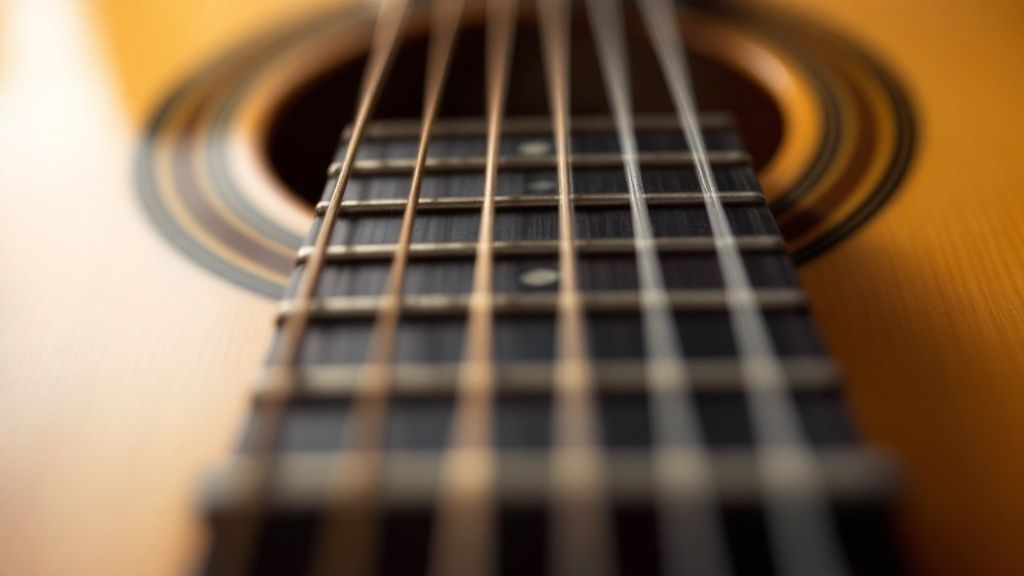
Good technique forms the foundation of beautiful classical guitar playing. Let's explore the key elements that help develop solid technical skills, based on proven teaching methods from experienced instructors.
Posture and Hand Position: The Foundation of Good Technique
Proper posture and hand position are essential for playing classical guitar well. A straight back and relaxed shoulders give you the freedom to move naturally. Your right hand, which plucks the strings, should maintain a gentle curve with controlled finger movements. The left hand, which presses the strings, needs just enough pressure without excess tension.
Think of it like holding a small bird – you need enough grip to keep it from flying away, but not so much that you hurt it. This simple comparison helps understand the delicate balance needed for good left-hand technique.
Addressing Common Challenges and Their Solutions
Students often face several technical hurdles as they learn. Excess tension in the hands, arms and shoulders is a common issue, usually caused by incorrect posture or using too much force. Regular practice of relaxation exercises can help resolve this. Another frequent challenge is uneven tone production, which happens when right-hand fingers don't strike the strings consistently. Focused practice on finger control and nail shaping helps develop a more reliable tone.
Many new players also struggle with smooth string crossings in the left hand. This skill is key for playing complex passages cleanly. Specific exercises that build finger independence and coordination can help master this fundamental technique.
Developing Proper Form and Avoiding Bad Habits
Starting with good habits is vital for long-term success. Poor technique can lead to physical strain, limited playing ability, and potential injury if not corrected early. The best approach is careful, slow practice that focuses on maintaining correct form and building muscle memory.
Regular self-evaluation and guidance from qualified teachers helps catch and fix problems before they become ingrained habits. This careful attention to technique builds a strong foundation that supports both basic and advanced playing skills, allowing for a lifetime of enjoyable guitar playing.
The Power of Ensemble Learning
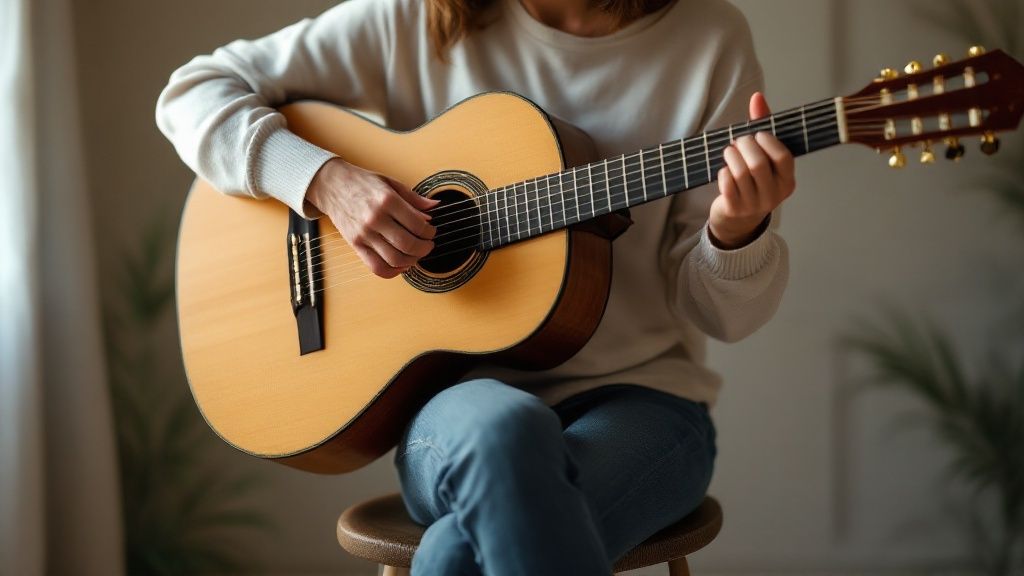
A strong technical foundation is essential for classical guitar students, but group playing adds an extra dimension to musical growth. Playing in a classical guitar ensemble creates unique learning opportunities that build on individual practice. This collaborative setting helps students expand beyond solo performance and develop crucial musical abilities.
Accelerated Musical Development Through Collaboration
Playing with others requires careful attention to timing, dynamics, and balance – key elements that can be overlooked when practicing alone. Maintaining steady rhythm in a group demands precise coordination with fellow musicians, which builds a stronger internal sense of time and improves rhythmic accuracy. Group playing also develops active listening skills as guitarists must focus on both their own part and how it fits with other voices.
Learning to blend your sound with others helps develop ensemble balance, a vital skill for any musician. Understanding how individual parts create the overall musical texture improves musicianship and appreciation for how different musical lines work together. Group performance accelerates growth in ways that solo practice cannot match. Recent studies show that school enrollment in classical guitar ensembles has increased by 400% over the past decade in the US, showing how popular this approach has become. Find more detailed statistics here.
Enhancing Motivation and Building Performance Skills
Playing in an ensemble provides a supportive community that boosts motivation. Working together toward shared musical goals creates strong bonds between members who encourage each other's growth. This positive environment especially helps students who struggle with practicing alone. Regular ensemble concerts also give invaluable experience with stage presence and performance etiquette.
Integrating Ensemble Work into Your Routine
Many classical guitar teaching methods include group training to help students progress. Here are some ways to add ensemble practice to your routine:
- Record your part and play along with the recording to simulate ensemble playing. This develops rhythmic independence and ensemble awareness.
- Practice sight-reading ensemble pieces to improve quick musical interpretation. This skill helps in any musical setting.
- Listen closely to professional classical guitar ensemble recordings to better understand balance, phrasing and interpretation. Learning from expert performances improves your own ensemble playing.
Regular ensemble practice helps classical guitarists build essential skills alongside their individual work. The benefits go beyond just technique, creating deeper musical understanding and lasting appreciation. This makes group learning a valuable part of any classical guitar program.
Navigating Modern Learning Pathways
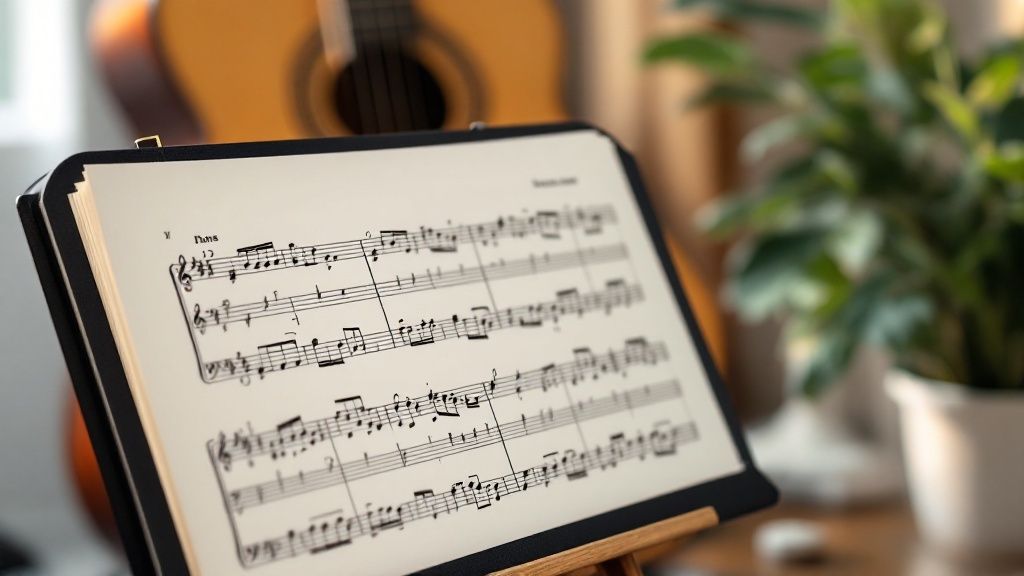
Classical guitar instruction offers a mix of time-tested methods and new learning tools. Students now have more options than ever to develop their skills. By understanding what each approach offers, guitarists can build an effective path to mastery.
Private Instruction: The Foundation of Classical Guitar Learning
Working one-on-one with a skilled teacher provides direct feedback and personal guidance. Teachers can spot technical issues, shape musical interpretation, and create custom lesson plans. These face-to-face sessions help build proper form and prevent bad habits from developing. The main drawbacks are the higher cost and the need to find an instructor who matches your learning style.
Digital Platforms: Growing Resources for Classical Guitar Students
Online learning tools now include video lessons, interactive apps, courses, and guitar communities. These digital options let students learn at their own speed from any location. While they work well alongside private lessons, students should carefully check the quality of online materials. Success with digital learning also requires good self-motivation and study habits.
Bringing Together Old and New Learning Methods
Many guitarists get the best results by combining private lessons with online resources. For example, taking weekly in-person lessons while using digital tools to practice concepts, discover new music, and connect with other players. Organizations like Austin Classical Guitar have supported music education for over 23 years. This mixed approach lets students customize their learning journey.
Finding Your Best Path Forward
The right learning method depends on your specific situation and style. Think about your budget, goals, and preferred learning environment. Consider whether you do better with structure or flexibility. Ask yourself if you stay motivated independently or need regular check-ins. Looking at these factors helps create a learning plan that works for you.
Mastering the Art of Deliberate Practice
Learning classical guitar requires more than just memorizing notes and chords. It needs focused, purposeful practice that maximizes your learning and development. This is where deliberate practice makes the difference – a proven method that helps you steadily improve and reach your potential as a classical guitarist.
Setting Clear Goals and Tracking Progress
Start by creating SMART goals – specific, measurable, achievable, relevant, and time-bound. Rather than a vague goal like "improve tremolo technique," set a concrete target like "play tremolo consistently at 120 BPM for one minute by month's end." This gives you something clear to work toward.
Keep track of your progress through practice recordings, a written journal, or musician-focused apps. Regular tracking helps you spot areas that need work and celebrate your wins. This creates a valuable feedback cycle that keeps you moving forward.
Structuring Practice for Maximum Impact
Simply repeating pieces over and over doesn't lead to real improvement. Break challenging sections into smaller chunks and practice them slowly with intention. For example, take a difficult arpeggio passage, master it at a slow tempo, then gradually speed up once you can play it cleanly.
Mix up your practice routine to develop different skills. Include technical exercises, sight-reading practice, and ear training. Like an athlete's cross-training program, this balanced approach builds well-rounded musical abilities while keeping practice sessions engaging.
Overcoming Plateaus and Building Resilience
Every student faces plateaus where progress seems to stall. When you hit a challenging passage, analyze what's causing the issue – is it a technical problem, rhythmic confusion, or memory slip? Once you identify the core problem, you can create targeted exercises to address it.
Deliberate practice also strengthens your mental game. By setting ambitious goals, stepping outside your comfort zone, and persistently working through difficulties, you develop the mental toughness needed for long-term success. This focused mindset, combined with consistent practice, is what leads to true mastery of classical guitar.
Advanced Learning Strategies for Continued Growth
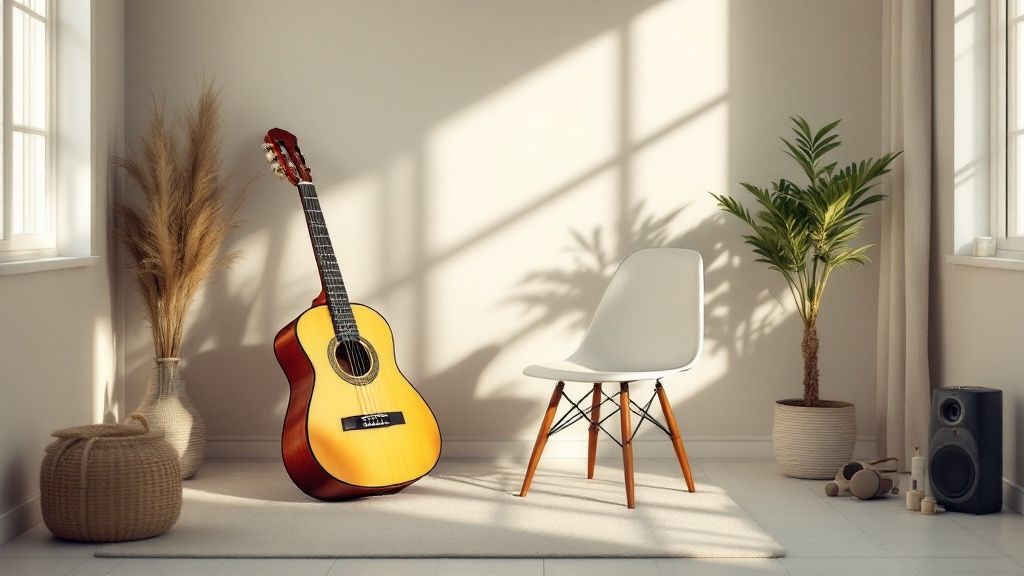
Taking your classical guitar skills to new heights requires smart practice strategies that build both technical ability and musical understanding. The right approach combines focused training with artistic development to help you progress steadily.
Making Practice More Effective
The key to improvement is deliberate practice – carefully planned sessions that target specific skills. Break challenging passages into small sections and practice them slowly before increasing the tempo. Keep a practice journal to track your progress and identify areas that need extra attention.
Choosing Music That Helps You Grow
Pick pieces that match your current level while still presenting an achievable challenge. Explore music from different composers and time periods to develop your interpretive abilities. This variety helps you become a well-rounded musician who can handle various musical styles with confidence.
Getting Ready to Perform
Moving from the practice room to the stage takes special preparation. Many professional musicians use visualization – mentally rehearsing their performance to reduce anxiety and improve focus. Practice performing for small groups to get comfortable playing under pressure and combine technical control with stage presence.
Learning From Your Playing
Regular self-evaluation helps you keep improving. Record your practice sessions and listen back with a critical ear to spot both strengths and areas for improvement. Make a clear list of technical issues to work on, like uneven tone or hand position problems. This systematic approach turns challenges into opportunities for growth.
By using these focused learning strategies in your daily practice, you'll see steady progress in your classical guitar journey. For musicians looking for professional help with their recording projects, Tune Tailors provides specialized audio production services.





